以充分包容的心做设计
2016-12-21
以充分包容的心做设计
Designing with Plenty of Tolerance
在军事基地上修建图书馆,需要的不仅仅是一种有形的结果,还有过程——让参与图书馆修建的士兵们能够从中学到新技能,从而让他们更容易回到平民身份的生活。
从1983年到2009年,在超过1/4个世纪的时间里,斯里兰卡一直在残酷的内战中挣扎。一方面是斯里兰卡的政府军,另一方面是力图在斯里兰卡北部建立独立王国的泰米尔叛军武装。这场内战造成了8万~10万人丧生,数十万人逃离家园。
政府军中有一个名叫辛哈的重要军团。该团由24个营组成,驻扎在首都科伦坡东北45km处的安贝普瑟军事基地。团中有许多在战事后期才入伍的17、18岁年轻士兵。他们中大多数人都出身贫苦家庭,入伍前无一技之长。如何重新整合这一大批年轻人,是斯里兰卡政府在内战后需要面对的重大难题之一。军方意识到了自身的责任,并推出了各项举措,以期为这些士兵的未来开辟新的道路。而军方的这一举措与政府长期致力于将斯里兰卡转变为知识型社会的想法不谋而合。于是,辛哈团负责人决定在基地上修建一座图书馆。这不仅可以为士兵接受进修教育提供支持,而且还可以为他们继续扩充培训知识提供一个环境。与此同时,图书馆还对安贝普瑟的民众开放。
图书馆包括参考资料阅览区、儿童图书馆、研究区、计算机实验室和报刊阅览区,可容纳100人。其自助餐厅计划于2015年6月启用。该图书馆由米琳达·帕蒂拉贾和甘加·拉特纳亚克设计。米琳达·帕蒂拉贾和甘加·拉特纳亚克在澳大利亚工作、学习和生活了近10年,直到4年前,他们才返回斯里兰卡。目前,米琳达·帕蒂拉贾在莫勒图沃大学任教,并与甘加·拉特纳亚克及另一名合伙人一起经营着一家名为Robust的建筑工作室。在谈到其团队设计的项目时,米琳达·帕蒂拉贾称:“我们想成为实践型研究者”。米琳达·帕蒂拉贾醉心于施工过程的研究。在完成研究后,他撰写了一篇名为《结构设计与施工知识之间的关系》的论文。2011年,米琳达·帕蒂拉贾获得了英国皇家建筑师学会主席颁发的“优秀博士论文奖”。
该项目中,对建筑师的职责规定非常笼统——修建一个服务于士兵和社区的图书馆。项目包括一个儿童图书馆和一个小型研究区域。建筑师在此基础上设计构思出了一个在各个方面都兼具可持续特点的建筑。建筑师们尤其注重建筑物的经济性,尽可能降低建筑材料成本。他们提议利用从附近运动场上挖掘到的废料来修建夯土墙。这样只需填充少量混凝土即可轻易建成墙体,并且这些墙体还具备保温功能。地面则采用回收的轨道枕木铺设。斯里兰卡铁路正逐步废弃老旧枕木,用混凝土代替,他们正在以低价出售老旧枕木。还有一种建筑材料是从废弃工厂中回收的钢架构件。

4 首层平面/Floor 0 Plan
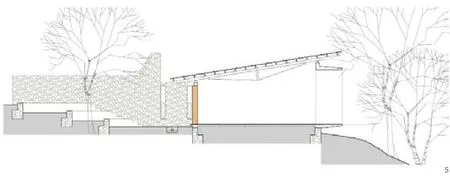
5 剖面/Section
此外,建筑师所设计的图书馆需要的运营和维护成本低廉。他们设计了通风屋顶和通风窗,用于捕获微风,这同时也优化了在斯里兰卡常用的通风系统。
Building this library on a military base was not only about the physical result, but also about the process: The soldiers who worked on it acquired new skills that will ease their transition back into civilian life.
Sri Lanka struggled through a brutal civil war for over a quarter century – from 1983 until 2009. On one side stood the Sinhalese government troops, on the other the Tamil rebels who were fighting for an independent state in the north of the island. Te conflict cost the lives of 80,000 to 100,000 people and drove hundreds of thousands to flee their homeland.
An important segment of the government troops was the Sinha Regiment, which comprises 24 battalions. It is stationed at a base in Ambepussa, 45 kilometers northeast of the capital city, Colombo. Many soldiers in the regiment are still young; they joined the Army at the age of 17 or 18 in the final phase of the war. Most of them come from underprivileged families and had no previous training. The reintegration of this large group of young men is one of the great challenges Sri Lanka faces in the aftermath of civil war. Te Army is aware of its responsibility and launches initiatives to open perspectives for the soldiers – and it is doing so in alignment with the government, which aims to transform Sri Lanka into a knowledge society over the long term. The officers in charge of the Sinha Regiment decided to establish a library on the base. Tis would support the continuing education of the soldiers and offer them a context in which they can expand the knowledge they acquire through their training. Te library would also be open to the civilian population of Ambepussa.
The library with a capacity of 100 occupants including reference area, children's library, research area, computer lab, newspaper area, and cafeteria is planned to be opened in June 2015. It was designed by Milinda Pathiraja and Ganga Ratnayake. Te pair lived, studied, and worked for almost ten years in Australia, until they moved back to Sri Lanka about four years ago. Today, Milinda Pathiraja teaches at the University of Moratuwa and runs the office Robust Architecture Workshop along with Ganga Ratnayake and another partner. "We want to be practicing researchers," says Milinda Pathiraja about the projects the team takes on. Te architect is fascinated about working with construction processes. At the close of his studies he wrote a thesis about the relationship between architectural design and construction knowledge. In 2011 he received a "President's Award for Outstanding PhD Tesis" from the Royal Institute of British Architects.
Te architects' mandate was formulated in very general terms: Build a library to serve the soldiers and the community. The program included a children's library and a small study area. Based on this, the architects conceived a building that is sustainable in every way. They paid special attention to economic aspects: The construction materials should cost as little as possible. Tey proposed making the walls out of rammed earth – using waste material excavated from a playground built nearby. These walls require only a small supplement of cement, they are easy to build, and they provide thermal mass. The floors are constructed from salvaged railroad ties. The Sri Lankan railway is gradually replacing its old wooden ties with new concrete ones, and selling the old ties for a pittance. Another building material used was steel framing members that were salvaged from decommissioned factories.
The architects also designed the building for low operating and maintenance costs. They provided cross ventilation using a monitor roof and monitor windows to catch the breeze – optimizing a commonly-used system in Sri Lanka.
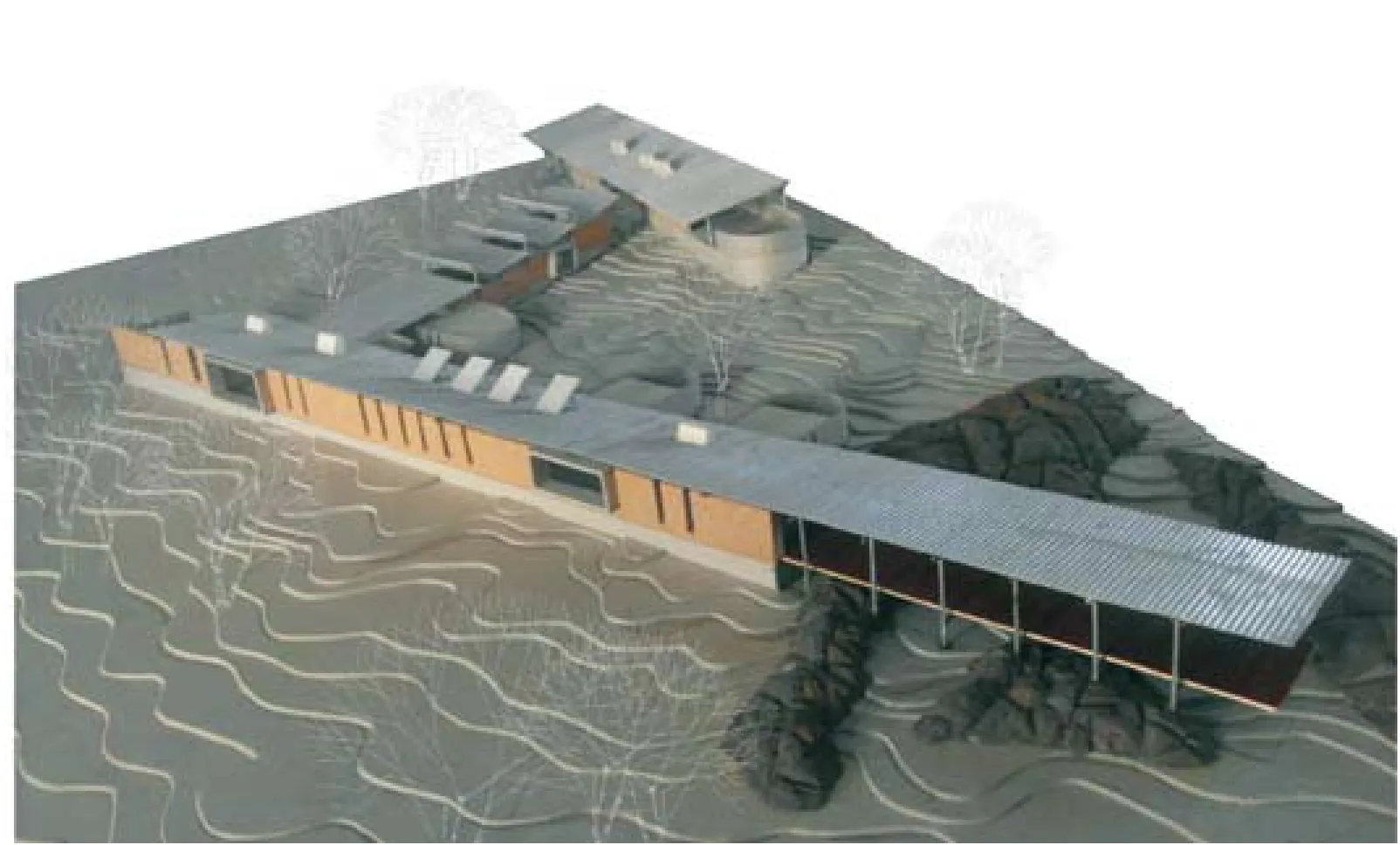
6 图书馆的三维效果图/3D view of the proposed library

7 立面/Elevation
问:您的论文是关于哪方面的?
米琳达·帕蒂拉贾:建筑和施工过程之间的紧密关系。建筑师经常会在施工工地上遇到不合格的工人,而这种情况在斯里兰卡尤为恶劣。早期,年轻人需拜访建筑师傅,并向经验丰富的工匠学习一段时间的技艺。而现在,这套学习系统几乎已不复存在,因为现在采用的是分包商制度。如今,相当于建筑师傅的主要承包商与实际施工人员并无联系。因此,我对施工过程进行研究,通过在施工过程将工人培训成建筑师。怎样在建筑工地上传授知识?如何将实际存在的建筑项目转化成概念并用作培训施工劳动力技巧的场地?
问:是什么激发了您对这些问题的思考?
帕蒂拉贾:我认为建筑师需要承担3种责任:首先是对自己和实践负责,其次是对客户负责,最后是对社会负责。我们一直想将这3种责任融入我们的工作中。我们想通过项目来帮助工人获得资质,并提高斯里兰卡的施工质量。将熟练工变成建筑师对我们来说很重要,但是,对于那些想从事建筑行业的所有工人来说,获得技能同样也非常必要。因此,施工过程是互惠互利的。坦率地说,与单纯的绘图工作相比,综合性工作更能令我们兴奋。像安贝普瑟这样的图书馆项目,可以让我们学到更多!
问:为什么军方想修建一座图书馆?在计算机的时代,书籍正在消亡……
帕蒂拉贾:这对极了,就全球趋势而言,是这样的,但是,在斯里兰卡并非每个人都拥有电脑。很多僧伽罗语书籍无法从网络上获得,我们仍然需要图书馆。
问:为什么军方会选择由你们来设计该项目?
甘加·拉特纳亚克:我们在基地附近参与修建了一栋私人住宅,期间,我们采用了稳定的泥土—混凝土砖块作为主要材料。一些高级军官看见了,觉得不错,于是想使用类似的材料。
问:所以您的论文与获得设计委托无关?
帕蒂拉贾:是的。客户并不知道我们是谁。他们甚至没有方案,虽然最后我们意识到他们只是想要一个传统图书馆。但是我们认为这个项目是一个机会,可以让我们引入一些新的东西。我们甚至也愿意免费工作。
问:这是一个无偿的项目?
帕蒂拉贾:是的。事实上,军方并没有项目预算。由于主要由士兵和指派人员参与施工,施工成本被降到了最低。
拉特纳亚克:军方经常自己修建小型自用建筑。毕竟,他们拥有足够多的劳动力。我们还发现,他们的床、桌子等所有军用家具都是由士兵自己制作的。我们想:我们也必须使用到这些劳动力。
问:当你们建议军方负责人将图书馆施工作为培训项目时,他们的反应是怎样的?
拉特纳亚克:最开始时,我们获得了他们的支持。
帕蒂拉贾:我们认为,我们正在以过程为核心,推动项目朝着积极的方向转变,这是非常切合实际的。图书馆代表着知识,而我们的整个施工过程就是施工知识。
问:你们是如何确定图书馆形态的?
拉特纳亚克:图书馆的设计耗时约4月。我们搭建了多个模型,并到现场考察了数次。场地上有许多树,而我们想要保留它们。因此,我们将图书馆设计成围绕这些树修建。事实上,到最后,只有一颗树被砍掉了。此外,从一开始,我们就非常明确,为了实现良好的自然通风和照明,图书馆必须建成狭长状的。虽然也设计了电气照明,但是,我们想尽可能减少电气照明的使用。
帕蒂拉贾:此外,设计还必须符合军用建筑的风格,即:个别区段必须尽量重复。整个建筑物由相同的元素构成。我们针对所有夯土墙和各种钢连接件制定了简单的制作说明书。我们制定了全部所需连接件的确切时间表,并与士兵一起检查整个系列的连接件。开始制作时,士兵们从简单构件入手,然后再逐渐过渡到最复杂的构件。针对这个问题,我在论文中提到了一种系统。现在该系统已投入使用。
问:不够完善的墙体不需要拆除和更换吗?
帕蒂拉贾:不需要。如果你计划像我们这样做的话,你设计的建筑就不能太过精致。你必须以足够包容的心态来设计建筑物和施工过程。这个过程必须稳健、灵活,且适应性强,可承受众多的介入和干扰。
问:你们会经常到施工工地上去吗?
拉特纳亚克:我们不住在安贝普瑟,但我们每隔两周会到建筑工地上去一次。军方指派了经验丰富的工头负责阅读计划方案,我们也可选用工头。此
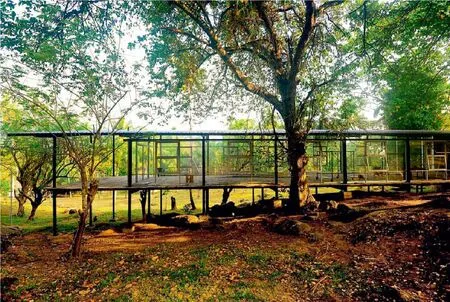
8 阅读室外景/Te reading room
Q: What is your thesis about?
Milinda Pathiraja (MP): Building has much to do with processes. One is often confronted underqualified workers on construction sites and in Sri Lanka this situation has definitely worsened. In earlier times, young people went to a master builder and learned their trade from an experienced artisan over a period of time. Today this system hardly exists anymore, because subcontractors are usually employed, and the main contractor – the present day equivalent to master builders – no longer has a relationship with the people who actually construct the building. So I searched for processes through which I can help train workers – as the architect. How can knowledge be transferred on the building site? How can real building projects be conceptually organized – architecturally – to act as training grounds for the development of construction labor skills?
Q: What intrigues you about questions such as these?
MP: I think an architect has three responsibilities: first to oneself and the practice; second, to clients; and third, to society. We always aim to bring these three dimensions together in our work. Trough our projects, we want to contribute to the qualifications of workers and we want to improve the quality of construction in Sri Lanka. Skilled workers are essential for us as architects, but acquiring skills is also necessary for all those workers aiming at building careers in the construction industry. So the benefits of cuh process are reciprocal. And, quite honestly, it's simply more exciting for us to work in a comprehensive capacity than simply drawing plans. With projects like the library at Ambepussa, we can learn so much!
Q: Why did the Army want to build a library? In the computer age, the book is on the way out...
MP: This is certainly correct, seen globally, but in Sri Lanka not everyone has a computer. And many Sinhalese books are not available through the internet. We still need libraries.
Q: Why did the Army choose you for this project?
Ganga Ratnayake (GR): We were involved in the building of a private residence near the base, where we used stabilized earth-cement blocks as the main materials. Some high-ranking officers saw it, thought that it was good – and wanted something with a similar material response.
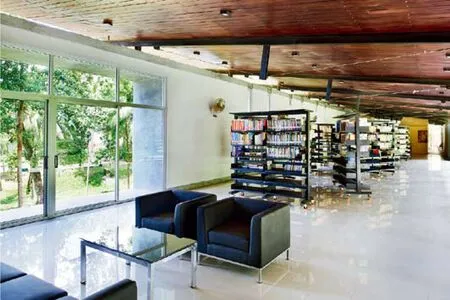
9 图书馆内景/Interior of the library
Q: So your thesis had nothing to do with this commission?
MP: No. Te clients didn't know who we are. Tey also had no program – although we ultimately realized one –they simply wanted a conventional library. But we saw this project as a chance to introduce something new. And we were also willing to work for free.
Q: Tis is a pro bono project?
MP: Yes. The Army actually has no budget for such projects. Te construction cost was minimal because the work was done mainly by the soldiers, and these were assigned to the job.
GR: The Army usually builds its own smaller buildings itself. After all, it has plenty of labor available. We also saw that the soldiers were making all the Army furniture: beds, tables, and so on. We thought: we must use this too.
Q: You proposed to the officers in charge the idea of treating the construction of the library as a training project. What were their reactions?
GR: We were met with support from the very beginning.
MP: Our argument was: We are pushing for positive change by placing the process at the center. This is perfectly fitting: A library represents knowledge, and our construction process is all about construction knowledge.
Q: How did you determine the form of the library?
GR: The design took about four months. We built several models and visited the site many times. Many trees are on the site and we wanted to keep them, so we designed the library around them. Actually, in the end, only one tree had to be cut down. Also, it was clear from the outset that the building would have to be narrow and elongated – for good natural ventilation and lighting. Te building does have electric lighting, but we wanted this to be required as little as possible.
MP: Also, the building would have to be designed to suit the way the army builds: individual sections repeated as many times as necessary. Te whole building consists of the same elements. We drew up simple instructions for building the walls out of rammed earth and making the various steel connectors. We provided an exact schedule of all the required connectors and went through the whole series with the soldiers. Tey began by making the外,我们有一个居住在附近的朋友,他可以对项目进行密切关注。
问:现在,士兵可以在没有指导的前提下修建一个一模一样的建筑吗?
帕蒂拉贾:我们的理念就是让他们能够复制出这个建筑。而现在,他们甚至还可以修建其他类型的建筑。这就是这个系统的魅力。退役后,他们可以利用自己学习到的技能修建自己的房屋。他们还将从军方获得一张培训证明书,可以用来应聘建筑行业的工作。在另一个项目中,我们看到了他们如何使用他们学习到的新技能。约一年前,我们在另一个地方开始修建一个类似的图书馆,但采用的是砖块。后来,工人们用相同的方法修建自己的房屋。他们复制了这个过程。
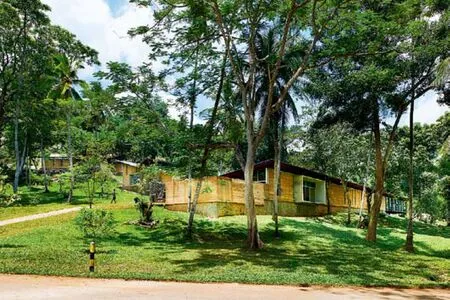
10 外景/Exterior view

11 建筑系统构成/Building system organization1-波纹钢屋顶板/Corrugated steel roof sheeting2-油漆面层木吊顶/Timber ceiling—stain finish3-循环利用I型钢屋顶桁架/Recycled steel I section roof truss4-素土夯实墙/Rammed earth wall construction5-混凝土楼板:水泥抛光面层/Concrete floor—cement polished finish6-碎石/石材地基/Rubble/stone foundation7-循环利用圆形钢柱支撑轻质甲板/Recycled circular steel columns support the lightweight deck8-循环利用铁路枕木/Recycled railway sleepers
问:你们如何组织培训?
拉特纳亚克:我们与100名士兵一起工作。这100名士兵被分成了若干小组,一组负责处理地面,而另一组负责处理墙体等等。我们先向士兵做示范,在这方面,我们获得了一些商界人士的支持,他们承担了对士兵的指导工作。士兵们都是好学生。他们基本上可以按照试错法进行操作。他们首先修建好墙体,然后由我们检查并提出建议。他们通过走小步、不停步的方法学习到了所有知识。现在,你可以很轻易地分辨出,哪些是第一次修建的,哪些是后来修建的。
问:这个项目面对的主要挑战是什么?
帕蒂拉贾:当然,最难的是如何在提高士兵技能的同时,组织开展一切活动,使建筑物本身也符合高标准要求。其次是与客户的合作。当你已经把建筑物摆在那里时,人们忽然有了新的想法,如:使用大理石铺设地面。这时,要想坚守原有的规划理念不是一件容易的事。而另一个总会遇到的问题就是可持续性建设。在纸上,一切看起来都还不错,但是,回到现实中时,所有变化都将接踵而至。如果想要在这种情况下有所作为,就必须学会接受妥协。如果太拘泥于意识形态,就会栽跟头。因此,我们认为:给客户想要的,但要以正确的方式进行。
拉特纳亚克:还有一项巨大的挑战就是士兵的工作速度。军队可以指派任意数量的兵士前往施工工地。这对于建筑师而言,是美梦,亦是噩梦。几乎在我们提出某些建议的同时,他们就已经完成了。
问:图书馆很快将会面向公众开放。民众真的会使用吗?他们与军队之间的关系是什么?
帕蒂拉贾:虽然在更大领域内,公众对此还存在不信任感,但是,居住在基地附近的居民对此却是付出了毫无保留的信任。一方与另一方是相互依存的关系。目前,军事基地上已经修建了一些公共设施,如:供本地学校使用的游泳池。虽然与公众的关系尚未达到军方预期,但是,你可以感受到军方将着眼于未来,并构建桥梁纽带。同时,这种桥梁纽带工程已经在各个领域中凸显出作用,如:村民自愿帮助修建图书馆。
问:士兵们可以从该项目中学到很多,那么你们呢?
帕蒂拉贾:我们也学到了很多!我们的实践经验尚且非常稚嫩,每一个建筑项目都可以为我们提供试验、学习和成长的机会。此次图书馆的施工是一段艰难的经历,但是也是成功的经历。对于我们建筑师而言,总是希望自己的想法最终变成现实,而这个项目的最终结果与我们的初衷非常接近。easiest pieces and gradually worked their way up to the most challenging ones. I had already developed a system for this in my thesis – now it was being put to use.
Q: Te less-perfect walls weren't torn down and replaced?
MP: That wasn't necessary. You can't design a delicate building if you plan to build as we did here. You have to design the building and the process with plenty of tolerance. The process must be robust, flexible, and adaptable – and be able to withstand many interventions.
Q: How often were you on the jobsite?
GR: We don't live in Ambepussa, but we visited the building site every two weeks. The Army assigned experienced foremen to the job who could read plans, and they allowed us to select them. In addition, a friend of ours who lives nearby kept a close eye on the job.
Q: Would the soldiers now be able to build the same building again without instructions?
MP: That was the idea – that they would be able to replicate this building. But now they can even build other buildings. It's about the system. With the skills they have learned, they will be able build their own houses when they return home after their military service. They also receive a certificate from the Army that authenticates their training, so they can apply for jobs in the construction sector. In another project we already saw how such newly-learned skills can be applied. About a year ago at another place we built a building similar to the library, but made of brick. Afterwards, the workers built their own houses in the same method. Tey replicated the process.
Q: How did you organize the training?
GR: We worked together with about 100 soldiers, whom we divided into groups. One group handled the floors while another handled the walls, and so on. We showed the soldiers how they must proceed, and in this we were supported by some tradespeople who served as instructors. Te soldiers were good students. Basically they followed the principle of trial and error. Tey built the first wall; we inspected it and gave recommendations for the next one. They learned everything in small, continual steps. Today you can easily see which walls were built first and which ones later.
Q: What were the main challenges of this project?
MP: Certainly the most difficult part was to enhance the skills of the soldiers while organizing everything so that the building itself would also meet high standards. The second challenge was the cooperation with the clients. Once the building was there, people suddenly had new ideas such as a marble floor, and it wasn't easy to insist on the original concept as planned. Tat's always a problem in sustainable construction: On paper everything looks fine, but then comes reality and all the change orders. If you want to achieve something within such a context, you must accept compromise. If you are too ideological, you will stumble. So we thought: Give the client what they want, but do it in the right way.
GR: A great challenge was also the rate at which the soldiers worked. Te Army is able to post any number of people to a construction site. For architects, this is both a dream and a nightmare: Barely after we had suggested something, it was already done.
Q: Te library will be opened soon, also to the public. Will civilians really use it? What is their relationship to the Army?
MP: Tere is some mistrust among the broader public, but the people who live around the base hardly have reservations. Each party is dependent upon the other. Today there are already some public facilities on the Army base, for example, a swimming pool used by the local schools. Te Army is not yet as close to the public as it would like to be, but you can sense the will to look ahead and to build bridges. And this bridge-building already works in many ways: Men from the villages also did volunteer work to help build the library.
Q: Te soldiers learned a lot through this project. What about you?
MP: We learned very much too! Our practice is still very young and every building project gives us the opportunity to experiment, learn and grow. The construction of this library was a difficult experience, but a satisfying one. In the end, for us as architects it's always a matter of seeing how the ideas turn out – and in this project the final result comes very close to our original intention.
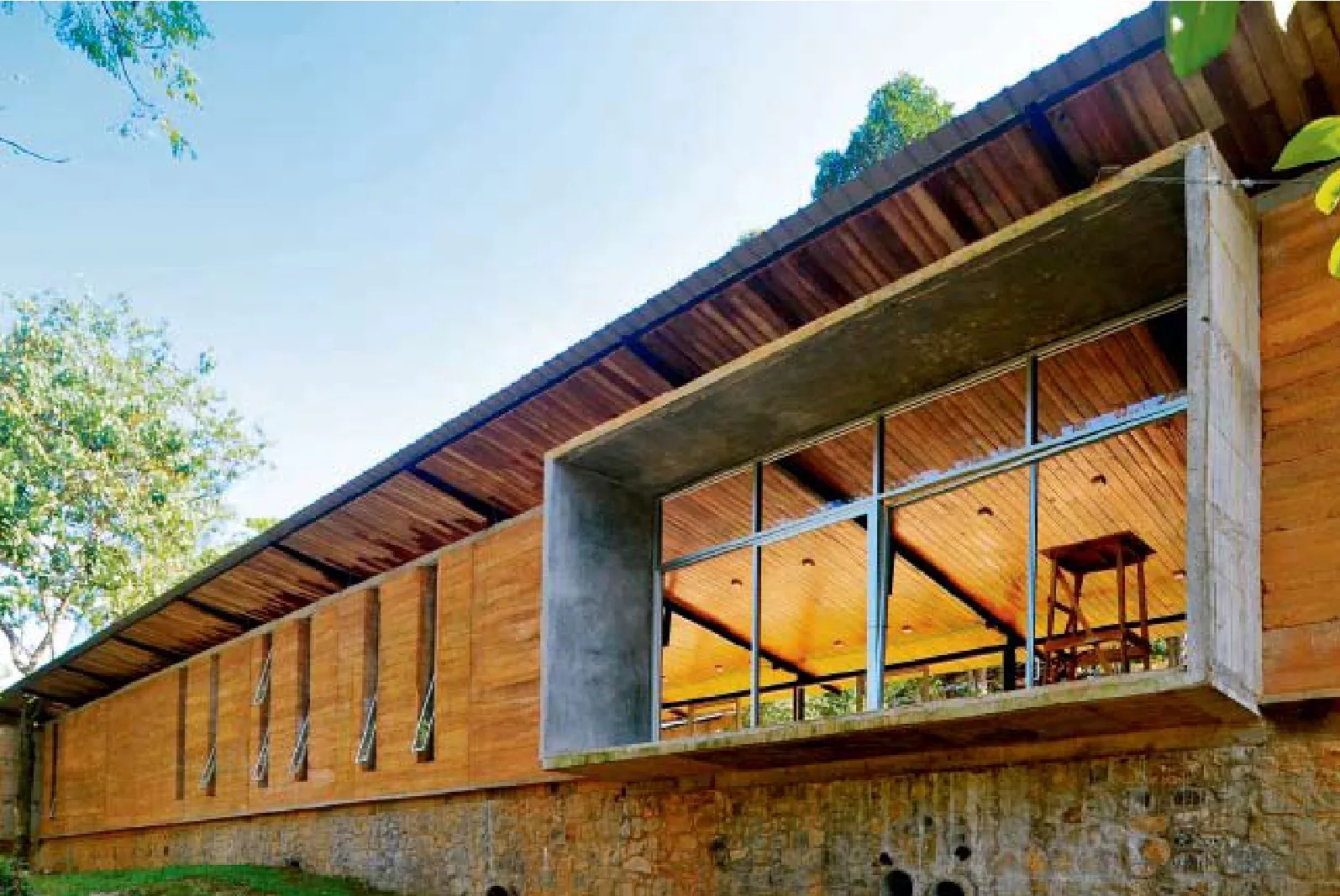
12 公共大堂的全景窗/Te common lobby with its panoramic window.

13.14 外景/Exterior views
